A New Mechanism of the Selective Photodegradation of Antibiotics in the Catalytic System Containing TiO2 and the Inorganic Cations
Abstract
:1. Introduction
2. Results and Discussion
2.1. Photocatalytic Degradation of Drugs in Wastewater—Screening Tests
2.2. Identification of Photocatalytic Degradation Products of the Selected SNs
2.3. Study of the Kinetics of Photocatalytic Degradation of SFF in the Presence of a TiO2/FeCl3 Mixture
2.3.1. pH Effect
2.3.2. Effect of the Initial Concentration of SFF
2.3.3. Effect of TiO2 Amount
2.3.4. Effect of FeCl3 Concentration
2.3.5. Formation of Fe3+ Complexes with SNs
2.4. Comparison of the Photocatalytic Degradation of SFF with That of Other SNs
2.5. Total Organic Carbon (TOC) Removal
2.6. Kinetics of Fe3+ Reduction during SNs Photodegradation in the Presence of a Mixture of TiO2/FeCl3
2.7. Fenton-Like Reactions
2.8. Photodegradation of SNs in the Presence of a TiO2/FeCl3 Mixture with the Addition of Methanol or Tert-Butanol
2.9. Photocatalytic Degradation of SNs in the Presence of a TiO2/FeCl3 Mixture under Aerobic and Anaerobic Conditions
2.10. Effect of SO42− Ions on the Photocatalytic Degradation of SNs
2.11. Comparison of the Susceptibilities of the Selected SNs to Photocatalytic Degradation
2.11.1. SNs Photodegradation in the Presence of TiO2 and/or FeCl3
2.11.2. Photodegradation in the Presence of TiO2/t-But
2.11.3. Photodegradation in the Presence of TiO2/AlCl3, TiO2/CrCl3 and TiO2/CuCl2
2.12. Influence of Steric Effect on SNs Binding
2.13. Mechanism of SFF Photodegradation in the Presence of TiO2/FeCl3
3. Materials and Methods
3.1. Reagents
3.2. Screening Tests
3.3. Studies of the Kinetics of SFF Photocatalytic Degradation
3.4. Comparison of the Photodegradation Kinetics of SFF with Those of Other SNs
3.5. Comparison of the Kinetics of SNs Photodegradation under Aerobic and Anaerobic Conditions
3.6. UPLC Analysis
3.7. Fe3+ Ions Determination
3.8. Identification of SNs Photodegradation Products
3.9. Total Organic Carbon Analysis
3.10. Analysis of Results
4. Conclusions
- The high bond polarity between the amide nitrogen and the heterocyclic substituents;
- The nearly linear structure of the SFF molecule;
- The specific arrangement of heteroatoms in the heterocyclic moiety, allowing the formation of a chelated complex;
- A high molar fraction of the molecular form in solution at the optimal pH for photocatalytic activity;
- Susceptibility to initiation of the degradation process by low-active, long-lived radicals.
Supplementary Materials
Author Contributions
Funding
Institutional Review Board Statement
Informed Consent Statement
Data Availability Statement
Conflicts of Interest
References
- Kümmerer, K. Antibiotics in the aquatic environment—A review—Part I. Chemosphere 2009, 75, 417–434. [Google Scholar] [CrossRef]
- Klein, E.Y.; Van Boeckel, T.P.; Martinez, E.M.; Pant, S.; Gandra, S.; Levin, S.A.; Goossens, H.; Laxminarayan, R. Global increase and geographic convergence in antibiotic consumption between 2000 and 2015. Proc. Natl. Acad. Sci. USA 2018, 115, E3463–E3470. [Google Scholar] [CrossRef] [Green Version]
- EMA. European Surveillance of Veterinary Antimicrobial Consumption 2019. Sales of Veterinary Antimicrobial Agents in 31 European Countries in 2017. (EMA/294674/2019). Available online: https://www.ema.europa.eu/en/documents/report/sales-veterinary-antimicrobial-agents-31-european-countries-2017_en.pdf (accessed on 7 May 2021).
- World Health Organization. WHO Report on Surveillance of Antibiotic Consumption: 2016–2018 Early Implementation; WHO: Geneva, Switzerland, 2018; Available online: https://www.who.int/medicines/areas/rational_use/oms-amr-amc-report-2016-2018/en/ (accessed on 7 September 2020).
- Statens Serum Institut National Food Institute, Technical University of Denmark. DANMAP 2019, Use of Antimicrobial Agents and Occurrence of Antimicrobial Resistance in Bacteria from Food Animals, Food and Humans in Denmark. Available online: https://www.danmap.org (accessed on 7 May 2021).
- Baran, W.; Adamek, E.; Ziemiańska, J.; Sobczak, A. Effects of the presence of sulfonamides in the environment and their influence on human health. J. Hazard. Mater. 2011, 196, 1–15. [Google Scholar] [CrossRef] [PubMed]
- Ghafur, A.; Vidyalakshmi, P.R.; Murali, A.; Priyadarshini, K.; Thirunarayan, M.A. Emergence of pan-drug resistance amongst gram negative bacteria! The first case series from India. J. Microbiol. Infect. Dis. 2014, 4, 86–91. [Google Scholar] [CrossRef] [Green Version]
- Giri, P.; Pal, C. Ecotoxicological aspects of pharmaceuticals on aquatic environment. Am. J. Drug Discov. 2014, 1, 10–24. [Google Scholar]
- Spellberg, B.; Bartlett, J.G.; Gilbert, D.N. The Future of Antibiotics and Resistance. N. Engl. J. Med. 2013, 368, 299–302. [Google Scholar] [CrossRef] [Green Version]
- Walsh, C.; Wencewicz, T. Antibiotics: Challenges, Mechanisms, Opportunities; John Wiley & Sons: Washington, DC, USA, 2020. [Google Scholar]
- Barancheshme, F.; Munir, M. Development of Antibiotic Resistance in Wastewater Treatment Plants. Antimicrobial Resistance—A Global Threat. In Antimicrobial Resistance a Global Threat; Yashwant, K., Ed.; IntechOpen Limited: London, UK, 2019. [Google Scholar]
- Humayun, M.; Raziq, F.; Khan, A.; Luo, W. Modification strategies of TiO2 for potential applications in photocatalysis: A critical review. Green Chem. Lett. Rev. 2018, 11, 86–102. [Google Scholar] [CrossRef] [Green Version]
- Byrne, C.; Subramanian, G.; Pillai, S.C. Recent advances in photocatalysis for environmental applications. J. Environ. Chem. Eng. 2018, 6, 3531–3555. [Google Scholar] [CrossRef]
- Tobaldi, D.M.; Piccirillo, C.; Rozman, N.; Pullar, R.C.; Seabra, M.P.; Škapin, A.S.; Labrincha, J.A. Effects of Cu, Zn and Cu-Zn addition on the microstructure and antibacterial and photocatalytic functional properties of Cu-Zn modified TiO2 nano-heterostructures. J. Photochem. Photobiol. A Chem. 2016, 330, 44–54. [Google Scholar] [CrossRef]
- Sacco, O.; Vaiano, V.; Rizzo, L.; Sannino, D. Photocatalytic activity of a visible light active structured photocatalyst developed for municipal wastewater treatment. J. Clean. Prod. 2018, 175, 38–49. [Google Scholar] [CrossRef]
- Adamek, E.; Baran, W.; Ziemiańska, J.; Sobczak, A. Effect of FeCl3 on sulfonamide removal and reduction of antimicrobial activity of wastewater in a photocatalytic process with TiO2. Appl. Catal. B Environ. 2012, 126, 29–38. [Google Scholar] [CrossRef]
- Duca, G. Homogeneous Redox Catalysis with Transition Metal Compounds in Oxide and Peroxide Systems. In Homogeneous Catalysis with Metal Complexes; Springer Series in Chemical Physics; Springer: Berlin/Heidelberg, Germany, 2012; Volume 102, pp. 11–121. [Google Scholar]
- Zhang, J.; Fu, D.; Gao, H.; Deng, L. Mechanism of enhanced photocatalysis of TiO2 by Fe3+ in suspensions. Appl. Surf. Sci. 2011, 258, 1294–1299. [Google Scholar] [CrossRef]
- Elghniji, K.; Atyaoui, A.; Livraghi, S.; Bousselmi, L.; Giamello, E.; Ksibi, M. Synthesis and characterization of Fe3+ doped TiO2 nanoparticles and films and their performance for photocurrent response under UV illumination. J. Alloys Compd. 2012, 541, 421–427. [Google Scholar] [CrossRef]
- Adamek, E.; Baran, W.; Sobczak, A. Effect of FeCl3 on the photocatalytic processes initiated by UVa and vis light in the presence of TiO2–P25. Appl. Catal. B Environ. 2015, 172–173, 136–144. [Google Scholar] [CrossRef]
- Ge, P.; Yu, H.; Chen, J.; Qu, J.; Luo, Y. Photolysis mechanism of sulfonamide moiety in five-membered sulfonamides: A DFT study. Chemosphere 2018, 197, 569–575. [Google Scholar] [CrossRef]
- Lian, J.; Qiang, Z.; Li, M.; Bolton, J.R.; Qu, J. UV photolysis kinetics of sulfonamides in aqueous solution based on optimized fluence quantification. Water Res. 2015, 75, 43–50. [Google Scholar] [CrossRef]
- Prajapat, G.; Gupta, R.; Bhojak, N. Microwave Assisted Synthesis, Structural Characterization, Thermal Analysis and Antibacterial Studies of Fe(III), Ni(II) and Cu(II) Complexes of Sulfanilamide. Orient. J. Chem. 2019, 35, 308–317. [Google Scholar] [CrossRef]
- Kanavouras, A.; Hernandez-Munoz, P.; Coutelieris, F.A. Packaging of Olive Oil: Quality Issues and Shelf Life Predictions. Food Rev. Int. 2006, 22, 381–404. [Google Scholar] [CrossRef]
- Manzo, R.H.; de Bertorello, M.M. Isoxamles II: Kinetics and Mechanism of Degradation of Sulfisoxazole in Moderately Concentrated Acids. J. Pharm. Sci. 1973, 62, 154–158. [Google Scholar] [CrossRef]
- Ma, Y.; Zhang, K.; Li, C.; Zhang, T.; Gao, N. Oxidation of Sulfonamides in Aqueous Solution by UV-TiO2-Fe(VI). BioMed Res. Int. 2015, 2015, 973942. [Google Scholar] [CrossRef] [Green Version]
- Yadav, M.S.P.; Neghi, N.; Kumar, M.; Varghese, G.K. Photocatalytic-oxidation and photo-persulfate-oxidation of sulfadiazine in a laboratory-scale reactor: Analysis of catalyst support, oxidant dosage, removal-rate and degradation pathway. J. Environ. Manag. 2018, 222, 164–173. [Google Scholar] [CrossRef]
- Ismail, L.; Rifai, A.; Ferronato, C.; Fine, L.; Jaber, F.; Chovelon, J.M. Towards a better understanding of the reactive species involved in the photocatalytic degradation of sulfaclozine. Appl. Catal. B Environ. 2016, 185, 88–99. [Google Scholar] [CrossRef]
- Baran, W.; Adamek, E.; Sobczak, A.; Makowski, A. Photocatalytic degradation of sulfa drugs with TiO2, Fe salts and TiO2/FeCl3 in aquatic environment—Kinetics and degradation pathway. Appl. Catal. B Environ. 2009, 90, 516–525. [Google Scholar] [CrossRef]
- Nahar, S.; Hasegawa, K.; Kagaya, S.; Kuroda, S. Adsorption and aggregation of Fe(III)-hydroxy complexes during the photodegradation of phenol using the iron-added-TiO2 combined system. J. Hazard. Mater. 2009, 162, 351–355. [Google Scholar] [CrossRef]
- Adamek, E.; Baran, W.; Ziemiańska, J.; Sobczak, A. The Comparison of Photocatalytic Degradation and Decolorization Processes of Dyeing Effluents. Int. J. Photoenergy 2013, 2013, 578191. [Google Scholar] [CrossRef]
- Kuburović, D.N.; Golubović, A.V.; Babinčev, L.M. Development of new smart metal nanomaterials based on titanium-dioxide for photocatalytic and antimicrobial activities. Mil. Tech. Cour. 2018, 66, 771–835. [Google Scholar] [CrossRef] [Green Version]
- Lin, S.; Huang, H.; Ma, T.; Zhang, Y. Photocatalytic Oxygen Evolution from Water Splitting. Adv. Sci. 2021, 8, 2002458. [Google Scholar] [CrossRef]
- Zhou, A.; Wang, Y.; Sun, S.; Xin, X.; Wang, M.; Zhao, Q.; Jia, R. Removal of sulfadiazine in a modified ultrafiltration membrane (PVDF-PVP-TiO2-FeCl3) filtration-photocatalysis system: Parameters optimizing and interferences of drinking water. Environ. Sci. Pol. Res. 2020, 27, 45605–45617. [Google Scholar] [CrossRef] [PubMed]
- Feng, W.; Nansheng, D. Photochemistry of hydrolyticiron (III) species and photoinduced degradation of organic compounds. Chemosphere 2000, 41, 1137–1147. [Google Scholar] [CrossRef]
- Mills, A.; O’Rourke, C.; Moore, K. Powder semiconductor photocatalysis in aqueous solution: An overview of kinetics-based reaction mechanisms. J. Photochem. Photobiol. A Chem. 2015, 310, 66–105. [Google Scholar] [CrossRef]
- Fox, M.A.; Dulay, M.T. Heterogeneous Photocatalysis. Chem. Rev. 1993, 93, 341–357. [Google Scholar] [CrossRef]
- Yang, H.; Li, G.; An, T.; Gao, Y.; Fu, J. Photocatalytic degradation kinetics and mechanism of environmental pharmaceuticals in aqueous suspension of TiO2: A case of sulfa drugs. Catal. Today 2010, 153, 200–207. [Google Scholar] [CrossRef]
- Curcó, D.; Giménez, J.; Addardak, A.; Cervera-March, S.; Esplugas, S. Effects of radiation absorption and catalyst concentration on the photocatalytic degradation of pollutants. Catal. Today 2002, 76, 177–188. [Google Scholar] [CrossRef]
- González, A.S.; Martínez, S.S. Study of the sonophotocatalytic degradation of basic blue 9 industrial textile dye over slurry titanium dioxide and influencing factors. Ultrason. Sonochem. 2008, 15, 1038–1042. [Google Scholar] [CrossRef]
- Chen, C.Y. Photocatalytic degradation of azo dye reactive orange 16 by TiO2. Water Air Soil Pollut. 2009, 202, 335–342. [Google Scholar] [CrossRef]
- Carp, O.; Huisman, C.L.; Reller, A. Photoinduced reactivity of titanium dioxide. Prog. Solid State Chem. 2004, 32, 33–177. [Google Scholar] [CrossRef]
- Kiwi, J.; Lopez, A.; Nadtochenko, V. Mechanism and Kinetics of the OH-Radical Intervention during Fenton Oxidation in the Presence of a Significant Amount of Radical Scavenger (Cl−). Environ. Sci. Technol. 2000, 34, 2162–2168. [Google Scholar] [CrossRef]
- Schneider, J.T.; Firak, D.S.; Ribeiro, R.R.; Peralta-Zamora, P.G. Use of scavenger agents in heterogeneous photocatalysis: Truths, half-truths, and misinterpretations. Phys. Chem. Chem. Phys. 2020, 22, 15723–15733. [Google Scholar] [CrossRef]
- Zhang, K.; Parker, K.M. Halogen radical oxidants in natural and engineered aquatic systems. Environ. Sci. Technol. 2018, 52, 9579–9594. [Google Scholar] [CrossRef]
- Prajapat, G.; Rathore, U.; Gupta, R.; Bhojak, N. Thermal and biological evolution of Fe(III)-Sulfanilamide complexes synthesized by green strategy. AIP Conf. Proc. 2018, 1953, 080025. [Google Scholar]
- Pervaiz, M.; Riaz, A.; Munir, A.; Saeed, Z.; Hussain, S.; Rashid, A.; Adnan, A. Synthesis and characterization of sulfonamide metal complexes as antimicrobial agents. J. Mol. Struct. 2020, 1202, 127284. [Google Scholar] [CrossRef]
- Chen, J.; Stepanovic, S.; Draksharapu, A.; Gruden, M.; Browne, W.R. A Non-Heme Iron Photocatalyst for Light-Driven Aerobic Oxidation of Methanol. Angew. Chem. Int. Ed. 2018, 57, 3207–3211. [Google Scholar] [CrossRef]
- Litter, M.I.; Slodowicz, M. An overview on heterogeneous Fenton and photo Fenton reactions using zero valent iron materials. J. Adv. Oxid. Technol. 2017, 20. [Google Scholar] [CrossRef]
- Li, X.; Li, J.; Bai, J.; Dong, Y.; Li, L.; Zhou, B. The Inhibition Effect of Tert-Butyl Alcohol on the TiO2 Nano Assays Photoelectrocatalytic Degradation of Different Organics and Its Mechanism. Nano-Micro Lett. 2016, 8, 221–231. [Google Scholar] [CrossRef] [Green Version]
- Thompson, T.L.; Yates, J.T. TiO2-based Photocatalysis: Surface Defects Oxygen and Charge Transfer. Top. Catal. 2005, 35, 197–210. [Google Scholar] [CrossRef]
- Louwerse, M.J.; Baerends, E.J. Oxidative properties of FeO2+: Electronic structure and solvation effects. Phys. Chem. Chem. Phys. 2006, 9, 156–166. [Google Scholar] [CrossRef] [PubMed]
- Baran, W.; Adamek, E.; Sobczak, A.; Sochacka, J. The comparison of photocatalytic activity of Fe-salts, TiO2 and TiO2/FeCl3 during the sulfanilamide degradation process. Catal. Commun. 2009, 10, 811–814. [Google Scholar] [CrossRef]
- Luo, T.; Wan, J.; Ma, Y.; Wang, Y.; Wan, Y.J. Sulfamethoxazole degradation by an Fe(II)-activated persulfate process: Insight into the reactive sites, product identification and degradation pathways. Environ. Sci. Process. Impacts 2019, 21, 1560–1569. [Google Scholar] [CrossRef] [PubMed]
- Liu, L.; Lin, S.; Zhang, W.; Farooq, U.; Shen, G.; Hu, S. Kinetic and mechanistic investigations of the degradation of sulfachloropyridazine in heat-activated persulfate oxidation process. Chem. Eng. J. 2018, 346, 515–524. [Google Scholar] [CrossRef]
- Ji, Y.; Fan, Y.; Liu, K.; Kong, D.; Lu, J. Thermo activated persulfate oxidation of antibiotic sulfamethoxazole and structurally related compounds. Water Res. 2015, 87, 1–9. [Google Scholar] [CrossRef] [PubMed]
- Inczedy, J. Analytical Applications of Complex Equilibria; Ellis Horwood Ltd.: New York, NY, USA, 1976. [Google Scholar]
- Fittschen, C.; Hippler, H.; Viskolcz, B. The β C–C bond scission in alkoxy radicals: Thermal unimolecular decomposition of t-butoxy radicals. Phys. Chem. Chem. Phys. 2000, 2, 1677–1683. [Google Scholar] [CrossRef]
- Reza, K.M.; Kurny, A.; Gulshan, F. Parameters affecting the photocatalytic degradation of dyes using TiO2: A review. Appl. Water Sci. 2015, 7, 1569–1578. [Google Scholar] [CrossRef] [Green Version]
- Tombácz, E. pH-dependent surface charging of metal oxides. Period. Polytech. Chem. Eng. 2009, 53, 77–86. [Google Scholar] [CrossRef]
- Uhlemann, T.; Seidel, S.; Müller, C.W. Site-specific binding of a water molecule to the sulfa drugs sulfamethoxazole and sulfisoxazole: A laser-desorption isomer-specific UV and IR study. Phys. Chem. Chem. Phys. 2018, 20, 6891–6904. [Google Scholar] [CrossRef]
- ISO. ISO 9887:1992(E) Water Quality—Evaluation of the Aerobic Biodegradability of Organic Compounds in an Aqueous Medium—Semi-Continuous Activated Sludge Method (SCAS); International Organization for Standardization: Geneva, Switzerland, 1992. [Google Scholar]
- U.S. Pharmacopeia. Available online: http://www.pharmacopeia.cn/v29240/usp29nf24s0_m79120.html (accessed on 18 July 2021).
- Selleckchem. Available online: https://file.selleckchem.com/downloads/struct/gentamicin-sulfate-chemical-structure-s4030.gif (accessed on 18 July 2021).
- Pubchem. Available online: https://pubchem.ncbi.nlm.nih.gov/ (accessed on 18 July 2021).
- Qiang, Z.; Adams, C. Potentiometric determination of acid dissociation constants (pKa) for human and veterinary antibiotics. Water Res. 2004, 38, 2874–2890. [Google Scholar] [CrossRef] [PubMed]
- Bielski, B.H.; Cabelli, D.E. Superoxide and Hydroxyl Radical Chemistry in Aqueous Solution. In Active Oxygen in Chemistry; Foote, C.S., Valentine, J.S., Greenberg, A., Liebman, J.F., Eds.; Structure Energetics and Reactivity in Chemistry Series; Springer: Berlin/Heidelberg, Germany, 1995. [Google Scholar]
- Crowell, R.A.; Lian, R.; Sauer, M.C., Jr.; Oulianov, D.A.; Shkrob, I.A. Geminate recombination of hydroxyl radicals generated in 200 nm photodissociation of aqueous hydrogen peroxide. Chem. Phys. Lett. 2004, 383, 481–485. [Google Scholar] [CrossRef] [Green Version]
- Amor, C.; Marchão, L.; Lucas, M.S.; Peres, J.A. Application of advanced oxidation processes for the treatment of recalcitrant agro-industrial wastewater: A review. Water 2019, 11, 205. [Google Scholar] [CrossRef] [Green Version]
- Mailloux, R.J. Teaching the fundamentals of electron transfer reactions in mitochondria and the production and detection of reactive oxygen species. Redox Biol. 2015, 4, 381–398. [Google Scholar] [CrossRef] [PubMed] [Green Version]
- Collin, F. Chemical basis of reactive oxygen species reactivity and involvement in neurodegenerative diseases. Int. J. Mol. Sci. 2019, 20, 2407. [Google Scholar] [CrossRef] [PubMed] [Green Version]
- Duesterberg, C.K.; Mylon, S.E.; Waite, T.D. pH effects on iron-catalyzed oxidation using Fenton’s reagent. Environ. Sci. Technol. 2008, 42, 8522–8527. [Google Scholar] [CrossRef]
- Burbano, A.A.; Dionysiou, D.D.; Suidan, M.T.; Richardson, T.L. Oxidation kinetics and effect of pH on the degradation of MTBE with Fenton reagent. Water Res. 2005, 39, 107–118. [Google Scholar] [CrossRef]
- Sági, G.; Csay, T.; Szabó, L.; Pátzay, G.; Csonka, E.; Takács, E.; Wojnárovits, L. Analytical approaches to the OH radical induced degradation of sulfonamide antibiotics in dilute aqueous solutions. J. Pharm. Biomed. Anal. 2015, 106, 52–60. [Google Scholar] [CrossRef]
- Bach, A.; Shemer, H.; Semiat, R. Kinetics of phenol mineralization by Fenton-like oxidation. Desalination 2010, 264, 188–192. [Google Scholar] [CrossRef]
- Mezyk, S.P.; Neubauer, T.J.; Cooper, W.J.; Peller, J.R. Free-radical-induced oxidative and reductive degradation of sulfa drugs in water: Absolute kinetics and efficiencies of hydroxyl radical and hydrated electron reactions. J. Phys. Chem. A 2007, 111, 9019–9024. [Google Scholar] [CrossRef]
- Cheng, S.; Zhang, X.; Yang, X.; Shang, C.; Song, W.; Fang, J.; Pan, Y. The multiple role of bromide ion in PPCPs degradation under UV/chlorine treatment. Environ. Sci. Technol. 2018, 52, 1806–1816. [Google Scholar] [CrossRef] [PubMed]
- Osfor, M.M.; Kensarah, O.; Azzeh, F.; Elmadbouly, M.A.; El-Qutry, M. Biochemical changes in lipid and carbohydrate metabolism in obese diabetic male albino rats. Int. J. Nutr. Food. Sci. 2013, 2, 24–30. [Google Scholar] [CrossRef]
- Lee, J.; Von Gunten, U.; Kim, J.H. Persulfate-based advanced oxidation: Critical assessment of opportunities and roadblocks. Environ. Sci. Technol. 2020, 54, 3064–3081. [Google Scholar] [CrossRef] [PubMed]
- Kwon, B.G.; Kim, J.O.; Kwon, J.K. An Advanced Kinetic Method for HO2/O2− Determination by Using Terephthalate in the Aqueous Solution. Environ. Eng. Res. 2012, 17, 205–210. [Google Scholar] [CrossRef] [Green Version]
- Abbas, A.A.; Jingsong, G.; Ping, L.Z.; Ya, P.Y.; Al-Rekabi, W.S. Review on LandWll leachate treatments. J. Appl. Sci. Res. 2009, 5, 534–545. [Google Scholar]
- Yu, X.Y.; Bao, Z.C.; Barker, J.R. Free radical reactions involving Cl•, Cl2−•, and SO4−• in the 248 nm photolysis of aqueous solutions containing S2O82− and Cl. J. Phys. Chem. A 2004, 108, 295–308. [Google Scholar] [CrossRef]
- Friedmann, D.; Hakki, A.; Kim, H.; Choi, W.; Bahnemann, D. Heterogeneous photocatalytic organic synthesis: State-of-the-art and future perspectives. Green Chem. 2016, 18, 5391–5411. [Google Scholar] [CrossRef] [Green Version]
- Pagsberg, P.; Munk, J.; Anastasi, C.; Simpson, V.J. Reaction of hydroxymethyl radicals with oxygen, nitric oxide, and nitrogen dioxide at room temperature. J. Phys. Chem. 1989, 93, 5162–5165. [Google Scholar] [CrossRef]
- Ross, A.B.; Neta, P.; Ross, A.B.; Neta, P. Rate Constants for Reactions of Aliphatic Carbon-Centered Radicals in Aqueous Solution; (No. NSRDS-NBS--70); Notre Dame University Press: Notre Dame, IN, USA, 1982. Available online: https://www.nist.gov/system/files/documents/srd/NSRDS-NBS-70-2.pdfURL (accessed on 19 July 2021).
- Wayner, D.D.M.; Houmam, A. Redox properties of free radicals. Acta Chem. Scand. 1998, 52, 377–384. [Google Scholar] [CrossRef]
- Wardman, P. Reduction potentials of one-electron couples involving free radicals in aqueous solution. J. Phys. Chem. Ref. Data 1989, 18, 1637–1755. [Google Scholar] [CrossRef] [Green Version]
- Denisov, E.T.; Denisova, T.G.; Pokidova, T.S. Handbook of Free Radical Initiators; John Wiley & Sons: Hoboken, NJ, USA, 2005. [Google Scholar]
- Standard Electrode Potential (Data Page). Available online: https://en.wikipedia.org/wiki/Standard_electrode_potential (accessed on 19 July 2021).
- Rajagopalan, R.; Chen, B.; Zhang, Z.; Wu, X.L.; Du, Y.; Huang, Y.; Zhang, H. Improved reversibility of Fe3+/Fe4+ redox couple in sodium super ion conductor type Na3Fe2(PO4)3 for sodium-ion batteries. Adv. Mater. 2017, 29, 1605694. [Google Scholar] [CrossRef] [PubMed]
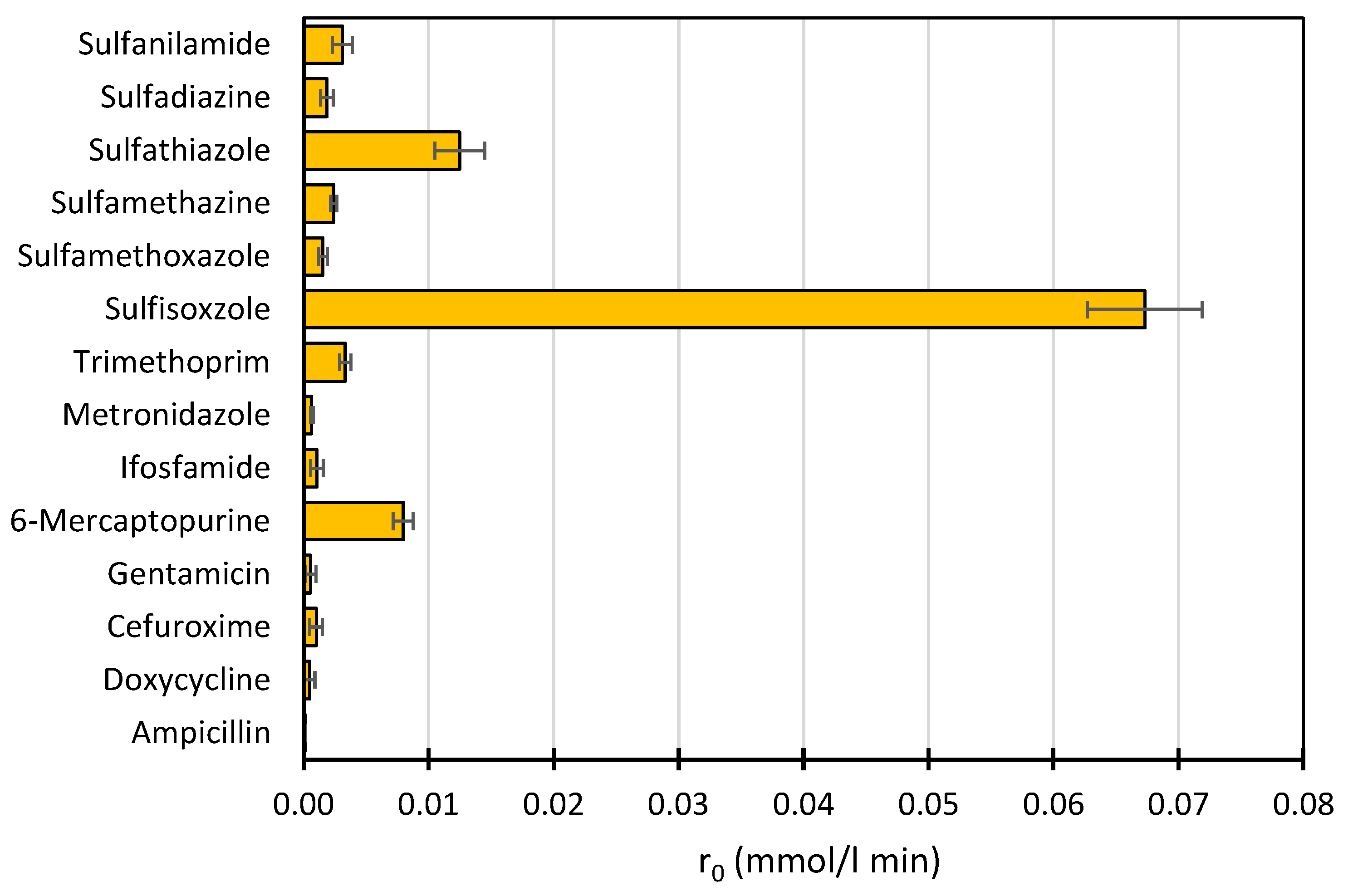
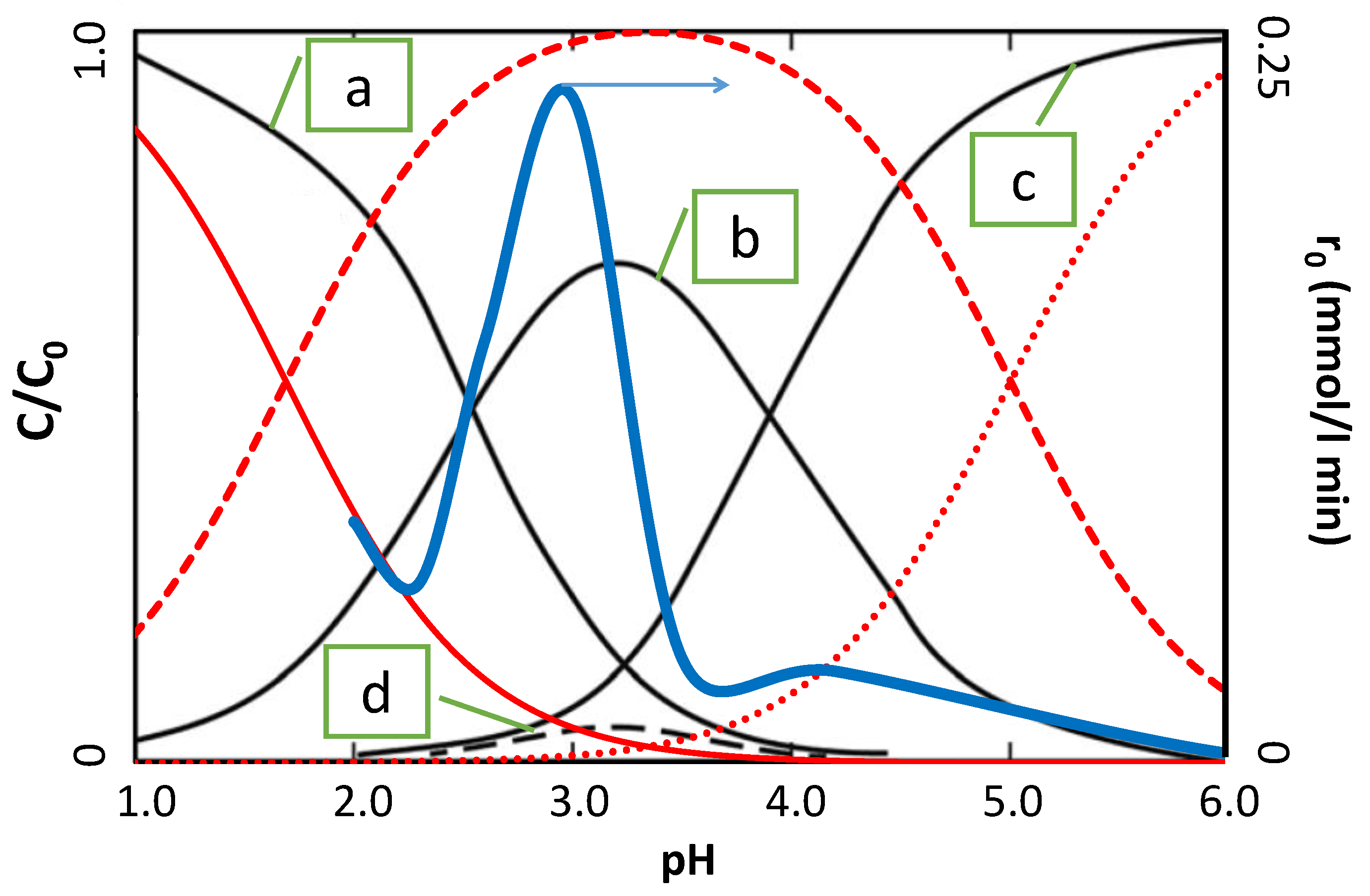
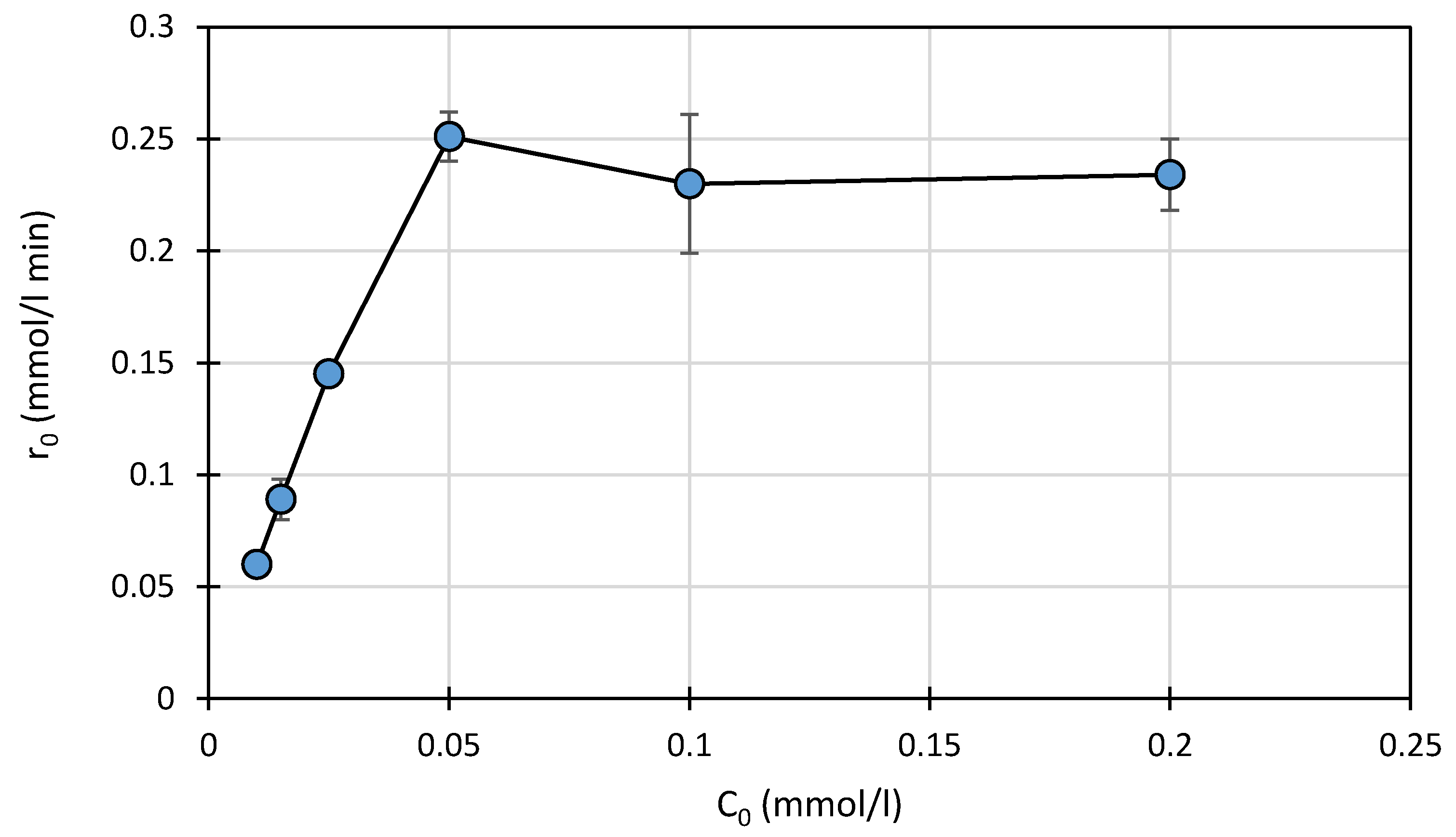
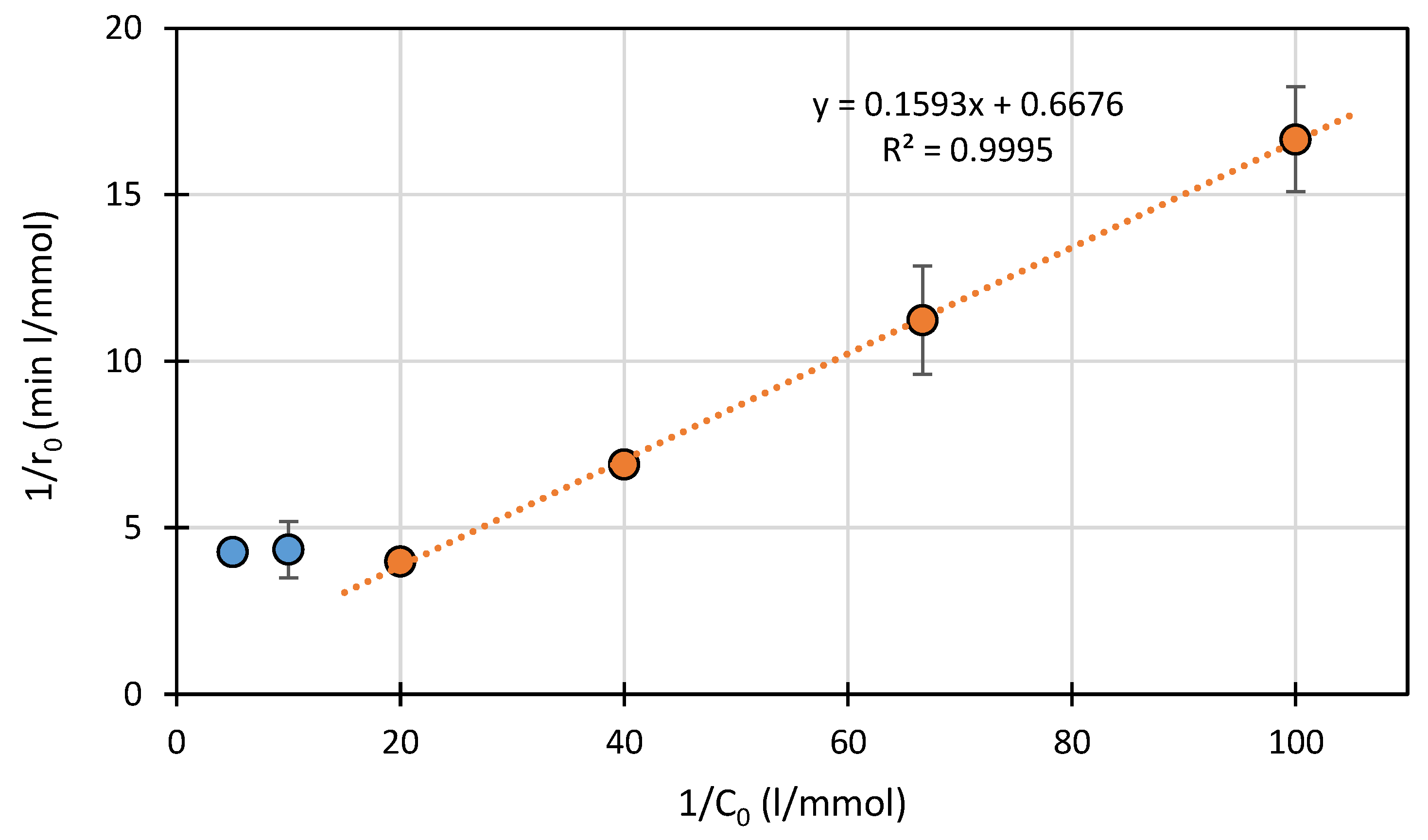
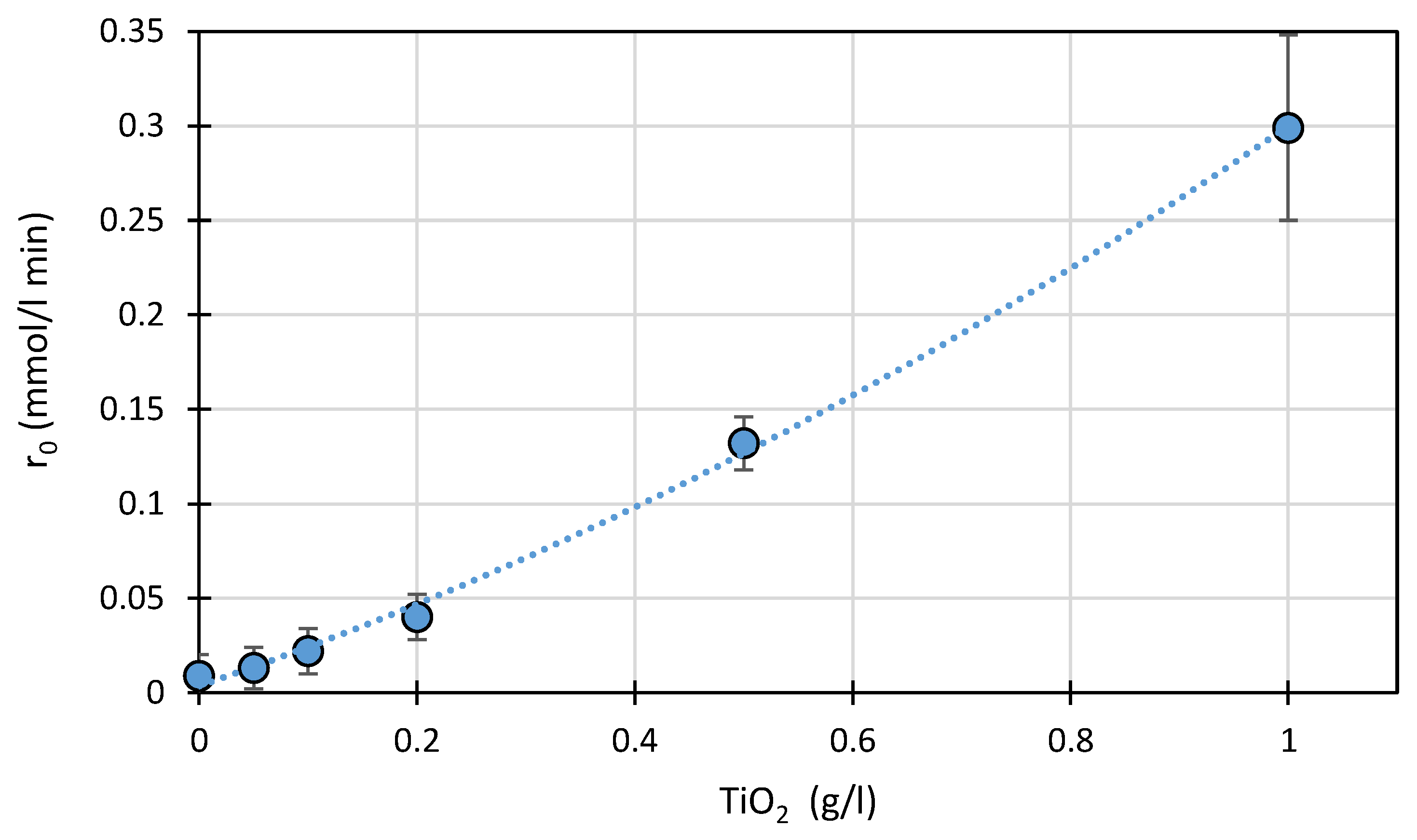

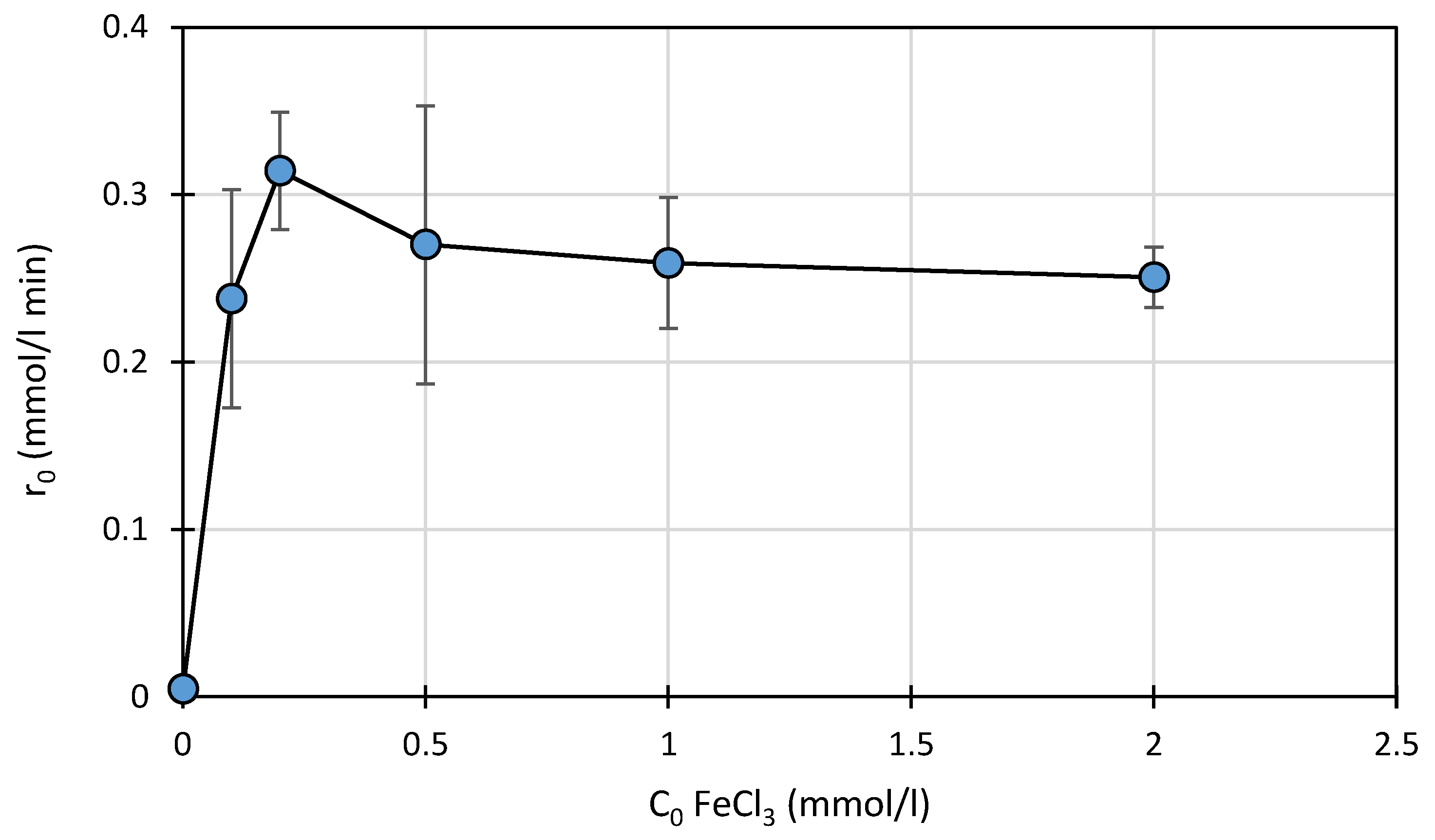
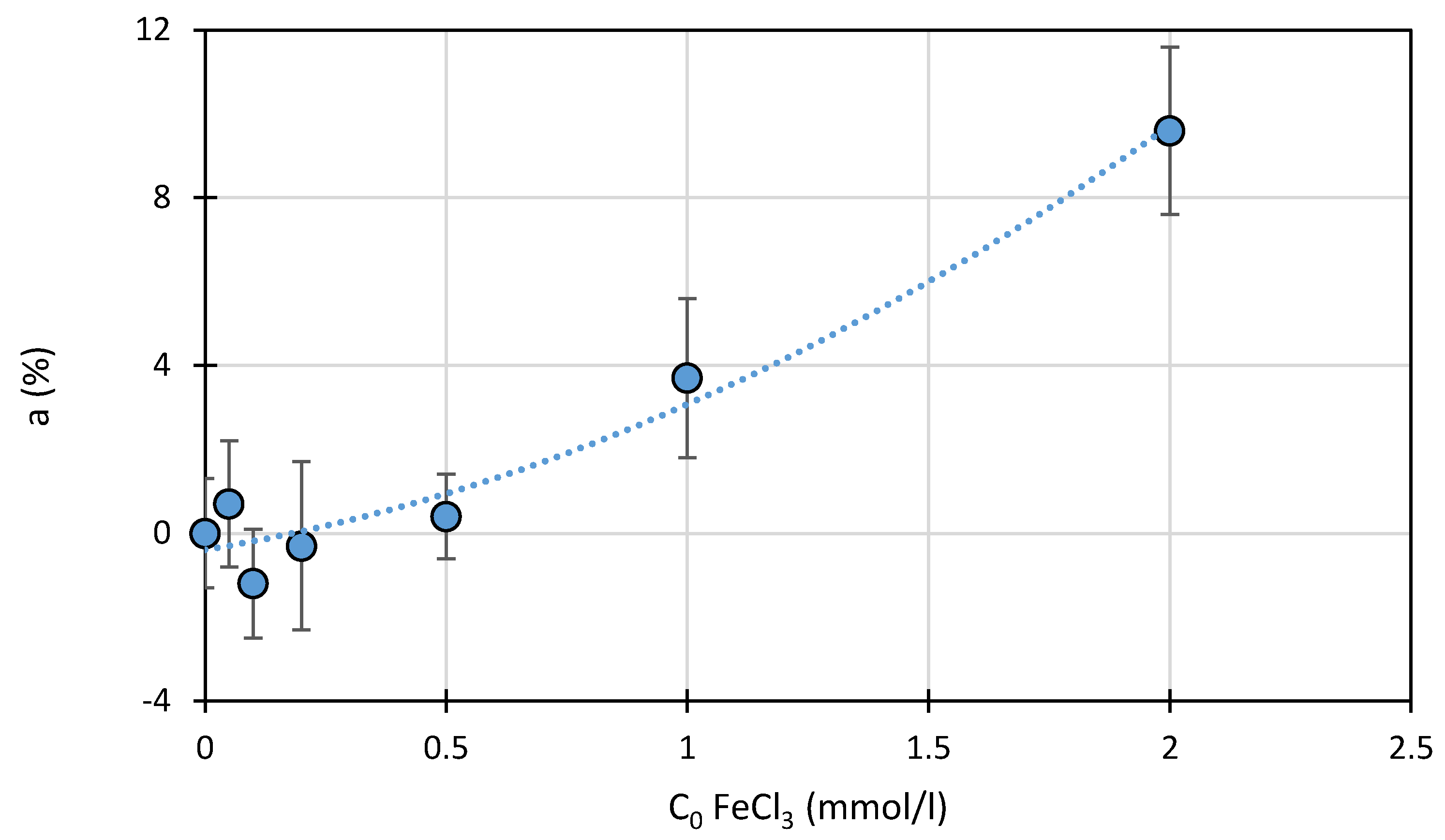
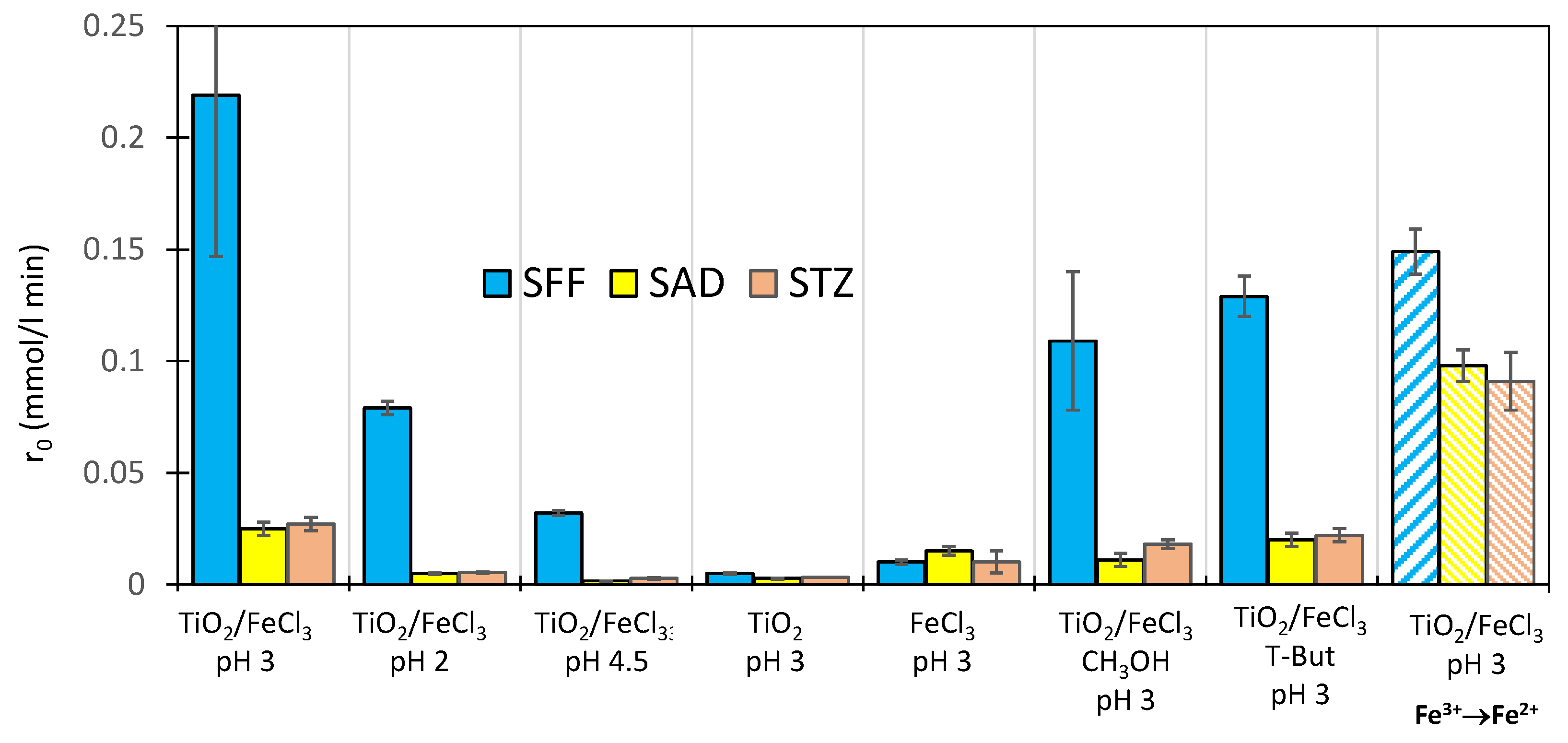
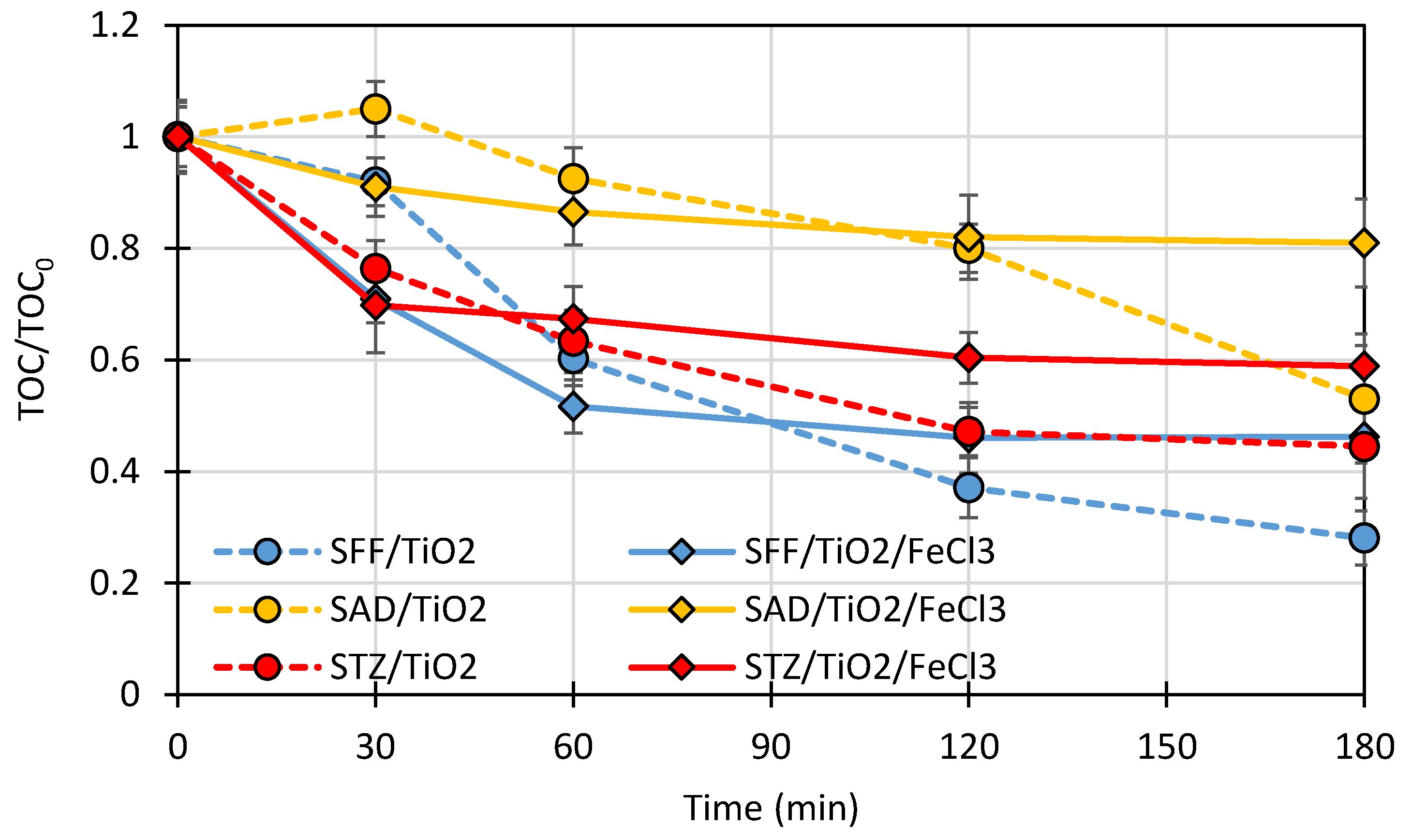
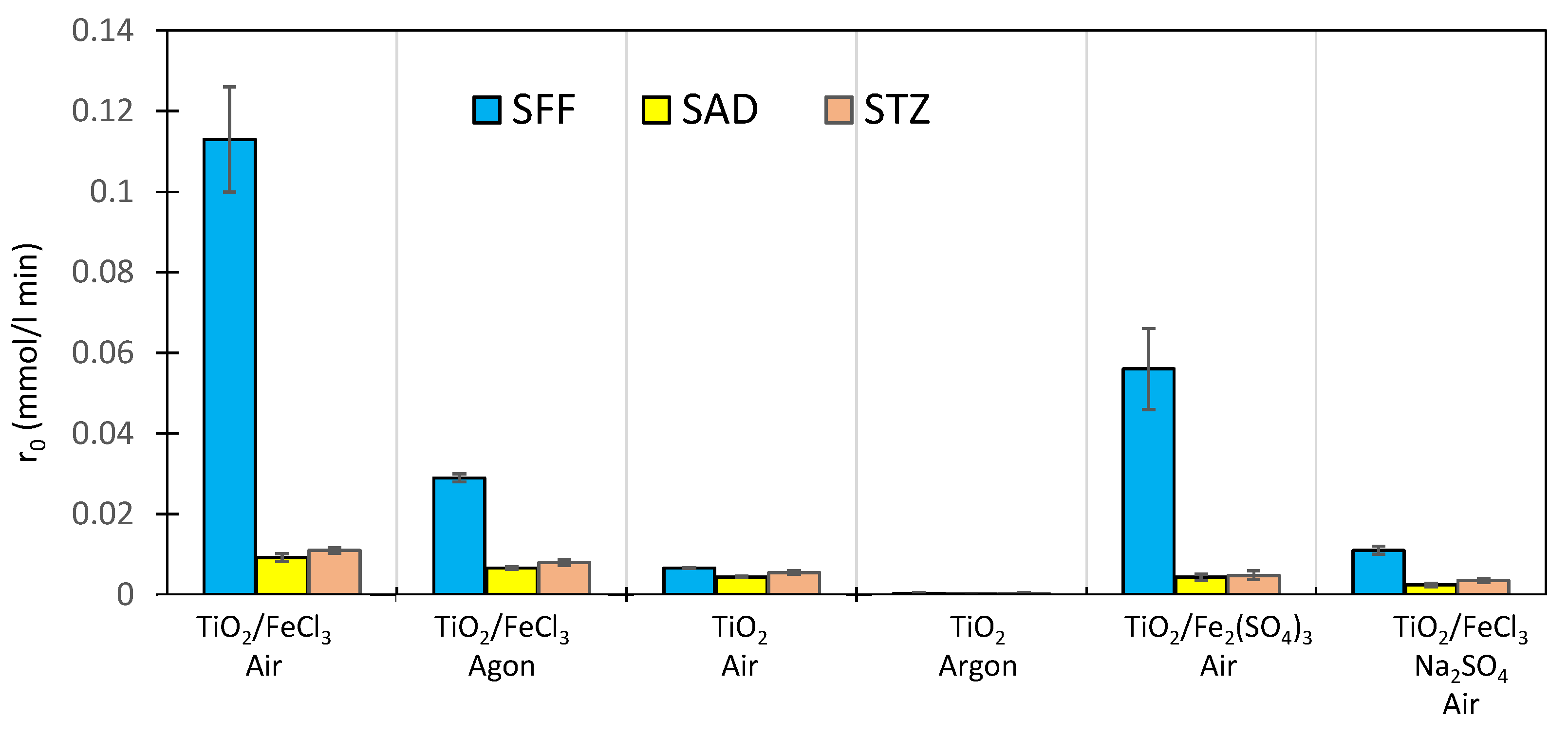
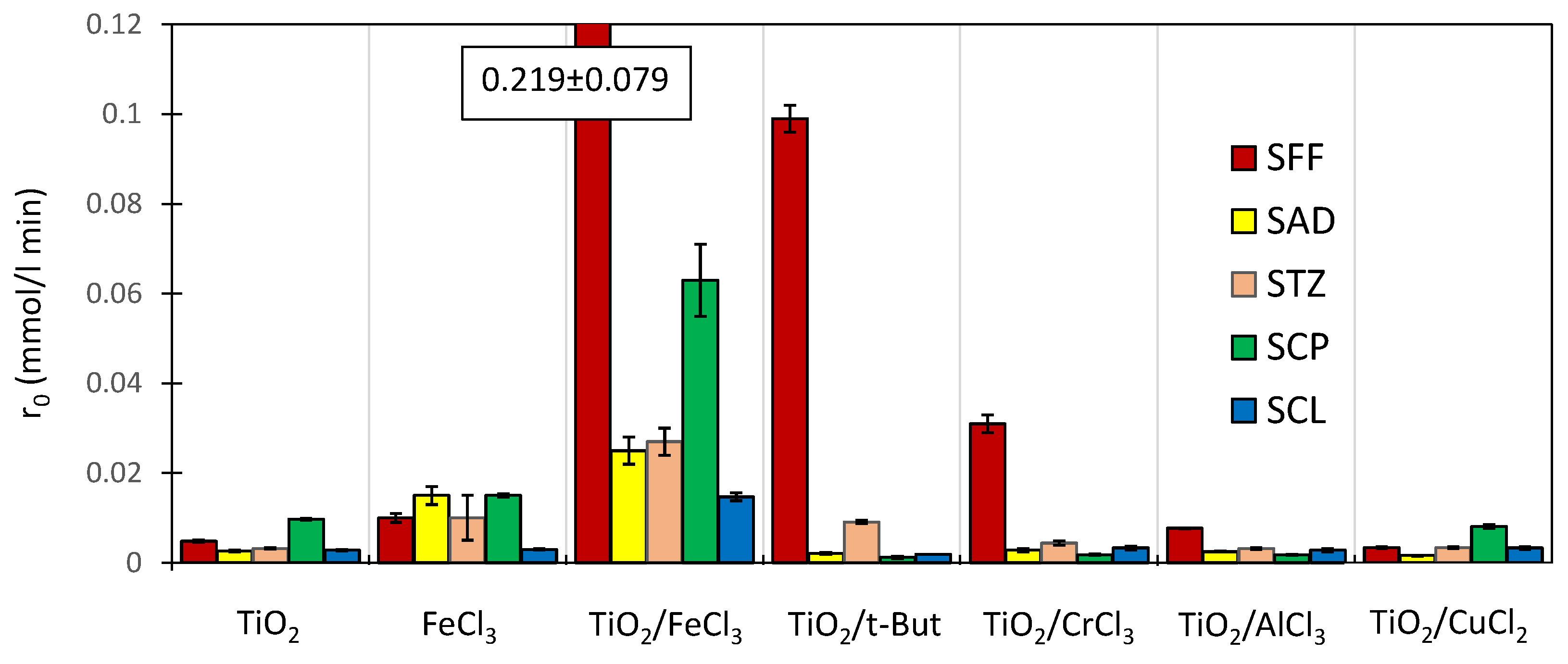
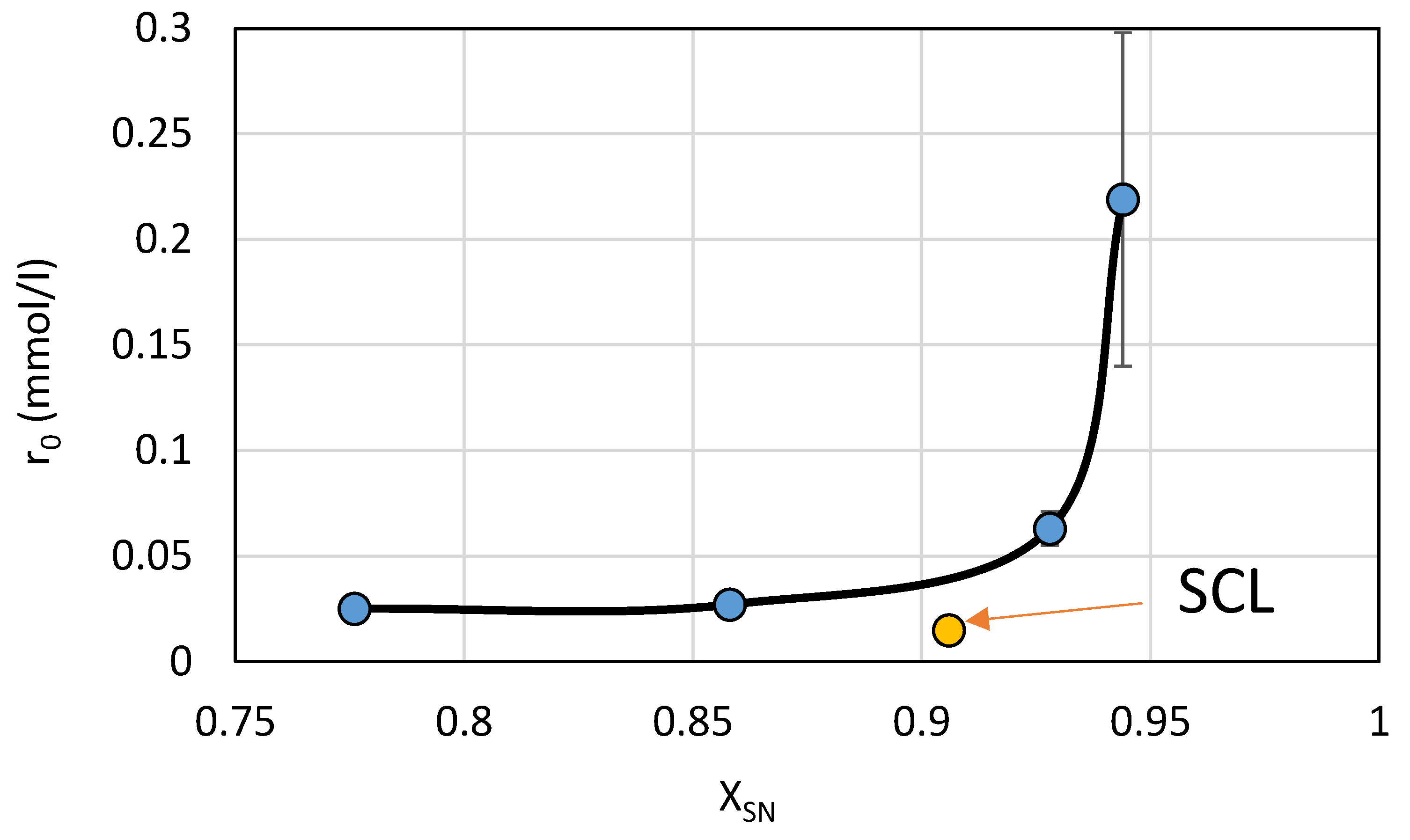
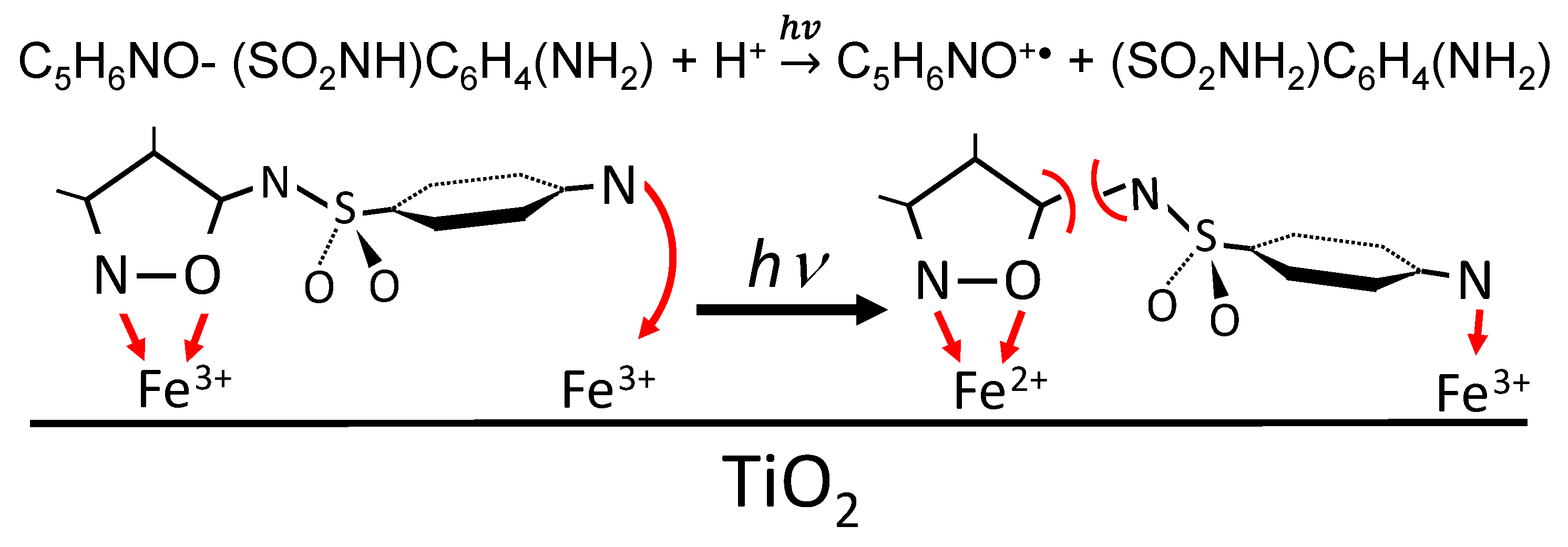
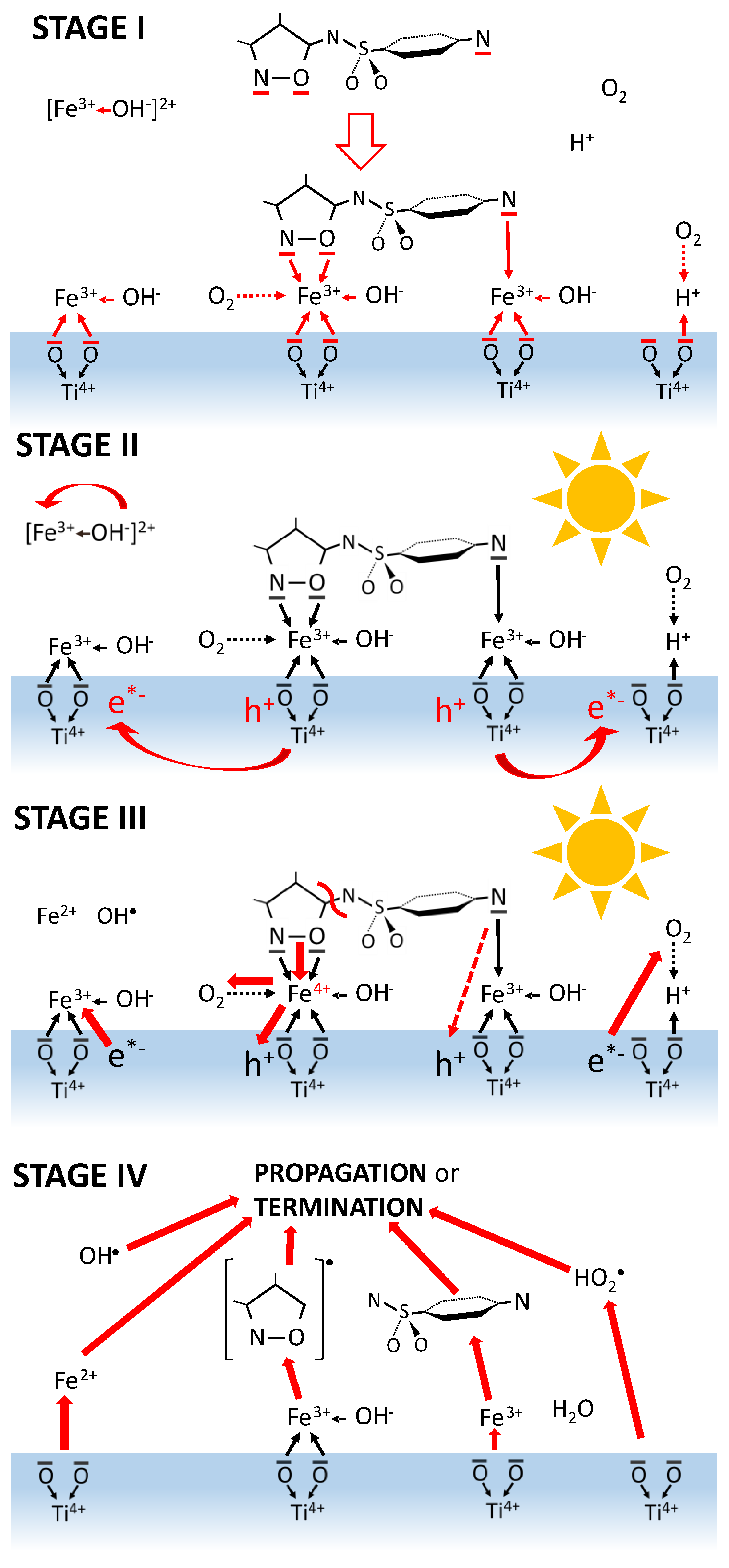
| SNs Catalytic System pH | tR (1) (min) | Detected Mass M + H+ (Da) | Proposed Molecular Formula | Calculated Mass M + H+ (Da) | Proposed Structural Formula (2) |
|---|---|---|---|---|---|
| SFF TiO2/FeCl3 pH 3.0 | 0.98 | 140.1073 | C8H13NO | 140.1075 |  |
| 1.37 | 174.0226 (3) | C6H8N2O2S | 174.0225 |  | |
| 1.74 | 196.1084 | C9H13N3O2 | 196.1086 |  | |
| 2.10 | 199.1078 | C9H14N2O3 | 199.1083 | 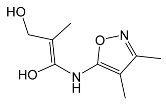 | |
| 2.45 | 153.1026 | C8H13N2O | 153.1028 |  | |
| 3.38 | 353.1278 | C15H21N4O4S | 353.1284 | 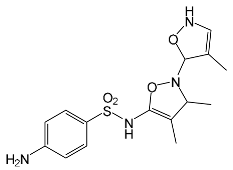 | |
| 5.62 | 379.1069 | C16H18N4O5S | 379.1076 | 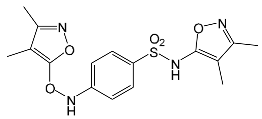 | |
| 6.08 6.55 | 533.1275 | C22H24N6O6S2 | 533.1277 |  | |
| 6.94 | 492.1006 | C20H21N5O6S2 (3) | 492.1011 | 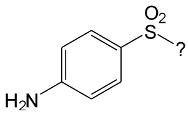 (4),(5) (4),(5) | |
| SAD TiO2/FeCl3 pH 3.0 | 2.52 2.58 | 262.0063 | C12H11N3O2S | 262.0061 |  |
| 2.64 | 276.0446 | C12H9N3O3S | 276.0443 | 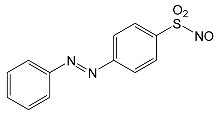 | |
| 2.98 3.22 | 357.0325 | C12H12N4O5S2 | 357.0327 | 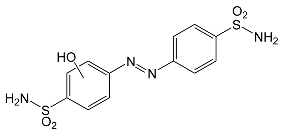 | |
| 3.42 | 263.0488 | C12H10N2O3S | 263.0490 |  | |
| 3.58 | 511.0535 | ? (4) | ? | ? | |
| 3.66 | 433.0626 | C18H16N4O5S2 ? | 433.0640 | ? | |
| STZ TiO2/FeCl3 pH 3.0 | 0.49 | 101.0176 | C3H4N2S | 101.0173 |  |
| 1.91 | 168.0594 | C7H9N3S | 168.0595 |  | |
| 2.22 | 290.0269 | C9H11N3O4S2 | 290.0269 | 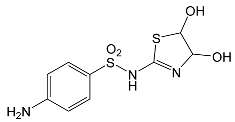 | |
| 2.61 | 196.0541 | C8H9N3OS | 196.0545 |  | |
| 3.68 | 346.0316 | C15H11N3O3S2 | 346.0317 | ? | |
| SFF TiO2 pH 7.5 | 1.29 | 189.0331 | C6H8N2O3S | 189.0334 | 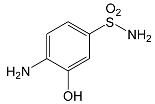 |
| 1.37 | 174.0226 (3) | C6H8N2O2S | 174.0225 |  | |
| 3.52 | 284.0705 | C11H14N3O4S | 284.0705 |  | |
| 3.88 | 298.0497 | C11H11N3O5S | 298.0498 | 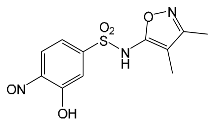 | |
| 3.94 | 300.0652 | C11H11N3O5S | 300.0654 | 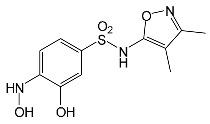 | |
| 4.92 | 284.0705 | C11H14N3O4S | 284.0705 | 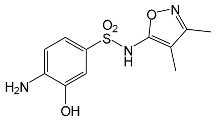 | |
| 6.35 | 387.0756 | C17H14N4O5S ? | 387.0763 | ? | |
| 6.37 | 392.1025 | C16H17N5O5S ? | 392.1029 | ? | |
| SFF FeCl3 pH 3.0 | 1.37 | 174.0226 (3) | C6H8N2O2S | 174.0225 |  |
| 2.10 | 199.1078 | C9H14N2O3 | 199.1083 | 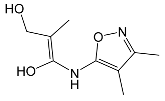 | |
| 2.52 | 113.0720 | C5H8N2O | 113.0715 |  | |
| 5.01 | 285.0547 | C11H12N2O5S | 285.0545 |  | |
| 5.86 | 452.0692 | C17H18N5O6S2 | 452.0698 | ? | |
| 6.80 | 563.1017 | C22H22N6O8S2 | 563.1019 | 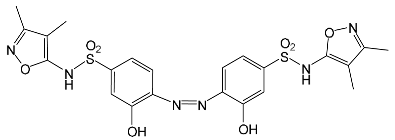 | |
| 6.97 | 638.1514 | ? | ? |
Publisher’s Note: MDPI stays neutral with regard to jurisdictional claims in published maps and institutional affiliations. |
© 2021 by the authors. Licensee MDPI, Basel, Switzerland. This article is an open access article distributed under the terms and conditions of the Creative Commons Attribution (CC BY) license (https://creativecommons.org/licenses/by/4.0/).
Share and Cite
Baran, W.; Cholewiński, M.; Sobczak, A.; Adamek, E. A New Mechanism of the Selective Photodegradation of Antibiotics in the Catalytic System Containing TiO2 and the Inorganic Cations. Int. J. Mol. Sci. 2021, 22, 8696. https://doi.org/10.3390/ijms22168696
Baran W, Cholewiński M, Sobczak A, Adamek E. A New Mechanism of the Selective Photodegradation of Antibiotics in the Catalytic System Containing TiO2 and the Inorganic Cations. International Journal of Molecular Sciences. 2021; 22(16):8696. https://doi.org/10.3390/ijms22168696
Chicago/Turabian StyleBaran, Wojciech, Mateusz Cholewiński, Andrzej Sobczak, and Ewa Adamek. 2021. "A New Mechanism of the Selective Photodegradation of Antibiotics in the Catalytic System Containing TiO2 and the Inorganic Cations" International Journal of Molecular Sciences 22, no. 16: 8696. https://doi.org/10.3390/ijms22168696
APA StyleBaran, W., Cholewiński, M., Sobczak, A., & Adamek, E. (2021). A New Mechanism of the Selective Photodegradation of Antibiotics in the Catalytic System Containing TiO2 and the Inorganic Cations. International Journal of Molecular Sciences, 22(16), 8696. https://doi.org/10.3390/ijms22168696








